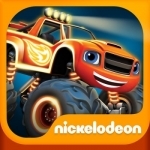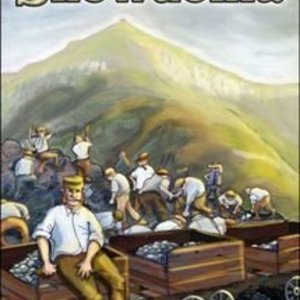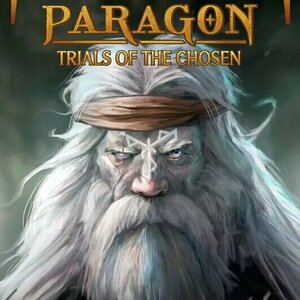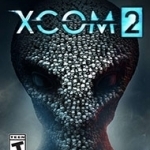
Metroburbia: The Anatomy of Greater London
Book
London's suburbs are home to many thousands of people who travel into the centre every day to work,...

Here Come the Warm Jets
Book
"Warren's first book of poems is highly self-reflective, interestingly interrogative, and a lot of...

Dispatch: Email meets GTD
Productivity and Business
App
Dispatch makes it easy to act on emails even when you're on the move. It lets you get rid of mails...

KORG Module
Music and Entertainment
App
The best sounds, available to everyone. Announcing a new high-quality mobile sound module app for...

Blaze and the Monster Machines - Racing Game
Education and Games
App
Get ready to race along with Nick Jr.’s Blaze and the Monster Machines in this fun truck racing...

Blaze and the Monster Machines - Racing Game HD
Education and Games
App
Get ready to race along with Nick Jr.’s Blaze and the Monster Machines in this fun truck racing...
Paul Kellett (118 KP) rated Snowdonia in Tabletop Games
May 4, 2019
Well, there are trains (many, many wonderful (and stupid) trains), and there are tracks, but Snowdonia is not your typical stuffy old train game.
Snowdonia is a worker placement Euro game (one of the best in My opinion) which has players working to complete the railway up to the top of Mount Snowdon.
While you are all working on the same track, this is a competitive game in which you score points for laying tracks, building stations and completing contracts.
The Dai is Cast
The game is set up by choosing which scenario you wish to play, and there are a good number, and laying out the track & station cards around the edge of the board. This is one of the great things about Snowdonia - each expansion is just a deck of cards which replace the original station & track cards, add a few additional rules and make a completely different experience.
The main board has a number of actions you can take like gathering resources, digging out rubble to clear the way for laying tracks (another action) or building stations to name a few. Each action location is further split into worker slots and in true worker placement fashion, these are limited so not everyone can do what they might want to.
There is a deck of contract cards, 3 of which are drawn at the start and replenished each round. If no-one has taken a contract, then the leftmost one is discarded and the other cards shift across with a new contract appearing on the right.
These contract cards are in two sections - the main part is a one time action that can give you a bonus to specific actions and is then spent. You keep the card though as the top part shows a game end bonus. If you satisfy the contract (by having laid a certain number of rails, built a number of stations, or dug enough rubble (and usually a combination of these things)) then you can get a decent bunch of points at the end of the game. Going after these can be rewarding but also quite tricky.
The backs of the contract cards also have a weather icon on them and this can be sunny, raining, foggy or, depending on the scenario, snowy. There is a weather track on the board which indicated the current weather as well as the forecast for the next 2 days so you can try to plan what you are going to do. The weather affects what actions you can take and how efficient you will be at doing them. Sunny days increase the amount of rubble you can dig and the number of tracks you can lay while rainy days decrease this and foggy days restrict the number of action spaces available. These work rates are marked on a track so if you get a run of 2 or 3 sunny days, you can get a good amount of work done.
The way this weather mechanic works really changes how each game feels. You can have games where it's very sunny and you can fair fly up the mountain or you could trudge through the fog gloomily laying the odd track and wishing you were in the pub.
It's warm in here, boyo, leave me to my pint will you
Ah, the pub. You have three workers, but only two are always available. The third one is found in the pub and will only come out if you get a train to take him up the mountain. Firstly, this involves buying a train when it becomes available and then paying a coal cube (not a cola cube, he's not that easily bought) to fuel the train. You only get him for that round after which he goes straight back to the pub.
This brings me on to resources. There are three types - Iron, Stone and Coal. Iron is needed to make tracks and build some station spots while Stone is used to build stations. Coal, as said, get's your man out of the pub.
Resources are restocked at the end of every turn and drawn blindly from a bag. The bag has finite resources determined by the player count but also contains 5 white cubes. These white cubes are the game's timer and represent "the company" coming in and doing work while you are messing about so keeping an eye on what resources are out is vital if you want to get a decent score.
When white cubes are drawn, they get placed on the AI track and will make the company dig, build or lay tracks so if you are not careful, the company will bring the game to a swift end.
Very Chuffed
The base game comes with 6 trains and each expansion adds more. Each train has it's own different special ability like granting you a bonus to your dig rate, letting you convert more Iron into Rail tracks or giving you a free build action.
All these really change how you can play and combined with the weather and the variety of contracts available really give a ton of replayability to Snowdonia.
Not only do the expansions come with trains, but the designer, Mr. Boydell has been creating additional trains for many a year, both as physical promo cards given away at conventions and with other games in his stable and as print and play cards posted up on his blog on BGG. Many of these trains are funny, silly or rude, often being inspired by events on the news and in the gaming world and there are A LOT of them. Check out www.snowdoniacentral.com to see the full list.
The Solo Game
Technically, the solo game is played exactly as the multiplayer game and is a "beat your best score" but that is really doing it a disservice. Like in the multiplayer game, the vastly different ways the weather, contracts and trains can interact makes each game feel totally different and the AI is unforgiving if you linger too long hoarding resources. This makes for a very challenging puzzle of resource optimisation and action efficiency that is very satisfying when you nail it.
There is a campaign of sorts where you play through a number of games using each train in order and there have been various challenges posted on Boardgame Geek.
Ooh, It's Big and Shiny
The Deluxe Edition (currently on Kickstarter) has collected all the expansions, many of them incredibly hard to find, (almost) all of the trains (even the print & play ones) and every other promo over released for Snowdonia and put them together in a lovely big box with a myriad up upgraded wooden pieces, all screen printed, as well as a larger board (with spaces to lay the track cards), more trains and some exclusive new scenarios. There is also the hint of a dedicated solo Automa to be added, but we will have to see, I wouldn't be bothered if it doesn't as the game is a superb solo experience as it is. Oh yeah, they have also added a set of cards that have each space on the board printed on each one so that you can use those to play the game if you are tight on space or want to take the game travelling. These were originally uploaded to BGG by a fan and I have used these many times when I have been working away as you can take them plus just enough pieces and cards to play solo and fit them all in a tiny box.
Snowdonia is My top Euro game and has been for a number of years, and I highly recommend going and checking it out.
Purple Phoenix Games (2266 KP) rated Paragon: Trials of the Chosen in Tabletop Games
Sep 18, 2021
Paragon: Trials of the Chosen (which I will lovingly refer to as Paragon from here on out) is a fantasy deck construction fighting card game where players will be outfitting their chosen avatars with awesome gear and abilities and sending them to battle against other players’ avatars. All players will know EXACTLY what is in their draw deck AND in what order because they have constructed it card by card and the deck will never be shuffled. Intrigued?
DISCLAIMER: We were provided a copy of this game for the purposes of this review. This is a retail copy of the game, so what you see in these photos is exactly what would be received in your box. I do not intend to cover every single rule included in the rulebook, but will describe the overall game flow and major rule set so that our readers may get a sense of how the game plays. For more in depth rules, you may purchase a copy online or from your FLGS. -T
To setup, each player chooses two avatars with whom they will play. Avatars belong to one or two different Disciplines, which allows players to construct their deck with Discipline-specific cards to be used during the game. As part of setup, each player will choose 20 cards from the gigantic deck of Equipment and Ability cards with which they will form their deck for play. Per the rules, each player will then place their chosen avatars and ordered decks in front of themselves along with a blue 1d10, the green 1d10 (all set to 1 to begin), and pile of Hearts tokens. Players draw their starting hand of five cards and the battle can begin!
The green 1d10 notates the round number, and the blue 1d10 per player represents their current Energy. To bring cards into play a player will spend the printed amount of Energy and track this on their 1d10.
Each round is played over several phases. The game is designed to play to 10 rounds, but players may play past 10 while keeping the round tracker and Energy static for all rounds after 10. The first phase is the Start Phase, and acts as a maintenance phase where players will activate any “Start Phase” effects from played cards, ready all exhausted cards, increase all the d10s, and draw the top card from their deck. Should a player be unable to draw a card during this phase due to the draw deck being empty, they immediately lose the game.
The second phase is the beefy Main Phase. This is where all the action happens. During this phase, players will take turns playing cards until both players have passed. On a turn a player will have the choice of five actions: Play a Card, Trigger an Activated Effect, Declare an Attack, Channel Energy, and Pass. To Play a Card the active player will pay the cost (in Energy) printed on the card and bring it into play exhausted. Cards brought into play this way will be attached to one of the avatars and act as an equipment or new ability, as long as the card played matches the Discipline of the avatar to which it is attached.
To Trigger an Activated Effect, the player will need to satisfy any qualifying conditions of the activation, which are printed on the card. These abilities can vary wildly and add immense strategy to play.
Once a player believes they have enough firepower attached to their avatars they may instead Declare an Attack by announcing their target and exhausting the card that is attacking. It is here that Paragon strays from the norm. Instead of damage simply being dealt to the opponent, the player may engage in a volley of playing Instant cards from hand (and paying their Energy costs) to add to the card stack. This is important, as the stack is then resolved in reverse order of play. So the last card to be played on the stack will be resolved first. This can result in attacks being nullified or shielded before they even proc. Sneaky and wily players will certainly use this phase wisely to draw out cards from their opponents’ hands. Once the stack is built, it is resolved and damage is calculated.
Players may instead elect to Channel Energy by exhausting one of their avatars to add 1 Energy to their pool. This may be repeated as long as the other avatar is available to be exhausted.
Lastly, and most easily, when players have no other actions they can or wish to complete, they may Pass in order to close out the round of phases.
When both players have Passed, the End Phase begins, and acts as another maintenance cleanup phase to ready players for the next round. This includes resolving any “End Phase” effects and increasing the round d10 by 1. The game ends once a player’s two avatars have been defeated or a player is unable to draw a card from their draw deck. The winner then boasts mightily in the face of their competitor and spews taunts and rematch challenges.
Components. This one is simple. Paragon has a giant stack of cards, a few d10s, and some wooden Heart tokens. The tokens are double-sided with a 1 printed on one side and a 3 on the other. These are obviously to track HP loss, and are fine. The 3d10 in this version are entry-level, and I will probably bling it out with some d10s that are more themed. The cards. Okay, I will certainly be sleeving this game. I want to keep my copy in excellent condition for as long as I can. In the last photo here, I splayed out the avatars that are currently included, and all the other cards stacked are the equipment and abilities to be attached to the avatars. I have no problems with the components in Paragon (I just want to get more exciting d10s to use).
There really is an insane amount of choice and customization that can be had in constructing a deck for the chosen avatars, and that is precisely why I mention in the opening that I have yet to understand all the components: how will I ever be able to perfect a combination that speaks to me and works with my style when I have about a zillion options available? I know many gamers will salivate over the amount of deliberation and possibilities contained in the box, and after several plays, I find myself weighing options in my head throughout the day. When you think about a game throughout the day and how you will attempt to play it next time, I feel that is a sign of a truly great game for you.
This is certainly not for everyone, but it definitely is for me. I truly cannot wait to try out different combinations, strategies, and deck configurations each time I play. I can also see Paragon being ripe for multiple expansions, with new avatars representing new Disciplines, or adding in expansion material that is themed for different IPs or historical eras. Well, I guess it is time to pick up a part-time job to fund my Paragon expansions.
If you are like me and enjoy games that offer near-infinite possibilities and the true feeling of never playing the same game twice, then Paragon needs to be on your shelf. The rules are easily-digestible, games take 30 minutes once you are familiar with it, and there are a ton of unique cards included in this box. Purple Phoenix Games gives Paragon an excited 5 / 6. I really think that with more plays and tweaks to my copy (maybe an expansion or two thrown in) this could eek up to a 6 and earn a Golden Feather Award from me. It is smooth, exciting, and just oozing with customization that many gamers are going to absolutely love. Go find yourself a copy and get it to the table right away!
Gareth von Kallenbach (980 KP) rated the Xbox One version of XCOM 2 in Video Games
Jun 19, 2019
The success of the game spawned XCOM 2 were once again players must take command of the team of soldiers fighting against an alien incursion.
This timeout players need to command a resistance unit and as before, delegate valuable resources to areas such as combat research, weapons research, scientific research, base expansion, equipment, and much more.
From there base players are free to upgrade the facilities, research new technologies, select which missions to take, and which soldiers and equipment to use. The level of detail is so high that players can even promote their troops, and mourn fallen comrades at the base Memorial.
Typically a player quips their vehicle and assigns squad of soldiers to a combat area where they can use their relegated turn units to move, take cover, assume support position, attack, reload, and so much more. When a turn is complete, players must watch while the enemy takes their turn and he can be a little frustrating to have your poor helpless Squaddie cut down in their prime by enemy you did not notice.
The enemies are extremely advanced, well-armed, incapable of Psionic powers such as being able to mind control your troops and even raise the dead which can be very frustrating is nothing is more demoralizing than cutting down an elite enemy unit only to see them resurrected back in the game.
As with the best elements of the series you’re constantly in an arms race to research new technology and weaponry to keep up with the enemy and just when you think you have turned the corner. The enemy will roll out new units and weaponry to once again put you at a disadvantage. Combine this with the fact that resources and funding are always paramount to your success, players must always maintain good relationships with there’s financial supporters as a lack of funds is more deadly than any combination of alien assaults.
The game is graphically impressive and highly diverse as there are multiple styles of play that can be employed which gives the game an unparalleled level of strategy. It should also be noted that the game is exceedingly difficult at times and I spoke to one player who said that he nearly deleted the game several times while playing it in frustration but was glad he stuck it out because the final confrontation was absolutely epic.
There is a multiplayer mode for the game that allows players to assemble a trained team of units and take on various challenges and while entertaining, I must admit that I spent the majority of my time playing the campaign mode but look forward to playing this more in the future.
XCOM 2 is a very worthy sequel that in many ways surpasses the original in terms of a deeper and more intense story and gaming experience that really draws you in. One can almost feel the horror at seeing the latest alien terror up close and watching your squad members could cut down as you desperately attempt to achieve the mission objective. Whether you want a dose of nostalgia or a solid challenge, I highly recommend XCOM 2 as it is not only a first rate game, it is one of the best games of the year and likely will be the recipient of several awards in the not too distant future.
http://sknr.net/2016/02/29/xcom-2/



